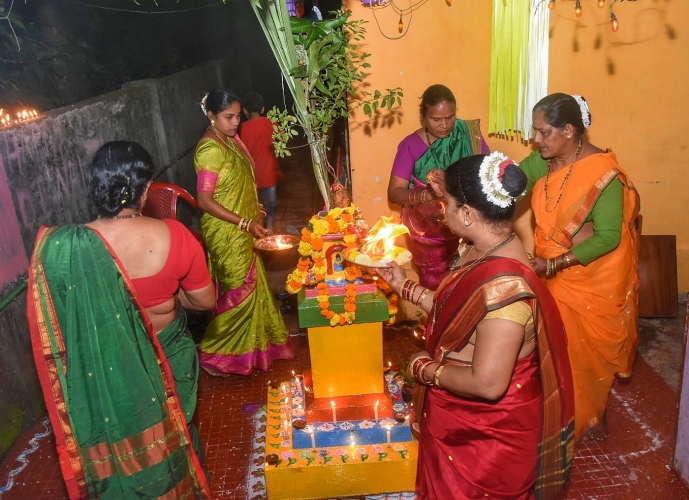
A file photo of Tulsi Vivah celebrations in the State.
Tulsi Vivah festival is one of the most auspicious festivals in the Hindu calendar, commemorating the marriage of Lord Vishnu to a Tulsi plant (basil). It is celebrated on the 12th day of the bright half of Kartik month.
The festival signifies the end of monsoon and the beginning of Hindu wedding season. Married women celebrate the festival for a long and blissful married life, while the unmarried pray to get good husbands.
According to Hindu mythology, the Tulsi plant (basil) was a woman named Brinda, a devotee of Lord Vishnu, who was blessed for her piety and given the power of invincibility.
She was married to the demon king, Jalandhar, a famous warrior. To defeat Jalandhar, the gods sought the help of Lord Vishnu, who disguised as Jalandhar, tricked Brinda by destroying her chastity.
When she came to know of this truth, she cursed Vishnu that he would become Shaligram (a black stone). Jalandhar lost the battle with the gods and was eventually killed as his wife could no longer protect him.
Brinda jumped into the funeral pyre of her husband. To compensate what he had done to her, Vishnu transformed her soul into the Tulsi plant and, he in the form of Shaligram, married her on the day of Prabodhini Ekadashi of Hindu Kartik month. This is the day celebrated in the form of the Tulsi Vivah Festival by Hindus.
Ceremony at homes
The Tulsi Vivah ceremony is performed at homes following all traditional social and religious customs and rituals.
A Mandap is built around the courtyard of the Tulsi plant and decorated with marigold flower garlands. The area is decorated with bamboo, palm-fronds, banana stems and wild shrubs. A stalk of the sugarcane representing the best man and the bride’s maid is represented by a branch of the tamarind tree. A branch of the Amla tree is also placed next to the pedestal. The Tulsi plant is decorated like a bride.
The Tulsi Vivah ceremony normally takes place late evening, depending on the availability of the pujari. Prior to the ceremony, some people narrate the story associated with Tulsi Vivah. Then, the Shaligram stone or the idol of Krishna or Vishnu, the groom, is placed next to the Tulsi plant, the bride.
The Vivah is performed normally by the pujari or if he is not available, by the head of the family who has experience, following all Hindu wedding rituals that include the recitation of the mantras, performance of the Kanyadan ceremony, tying the cloth to the Shaligram and Tulsi plant and removing it after the last mantra is recited, tying of the mangalsutra on the Tulsi plant, showering of flowers on the newly married couple, distribution of prasad, etc.
Loliem ceremony
The festival is performed at the Mahamaya Kurtarkarin temple in Tamnem, Loliem-Canacona, with a peculiar ceremony.
Suvasinis (married couples) of Pagi (fisherfolk) community of Tamnem celebrate the Tulsi Vivah of the deities of the Mahamaya Kurtarkari temple in a unique way.
Dressed with nine yard saris, decked with gold jewellery and hair adored with fragrant zayo, they gather near the temple after 10 pm on Tulsi Vivah day. They bring along with them Niveli Konde (cacti) pieces, both ends cleaned, in one a cavity made and filled with oil and cotton is inserted in it, the other is made into a glove-like pattern so that it fits on the fingers of the women.
The women wear these on their ten fingers, one on each finger and enter the temple where the pujari performs the Tulsi Vivah.
At around midnight, the cacti wicks are lit from the sacred fire by the women. They then emerge from the temple using their skill to maintain balance, so that the oil does not spill and the flames do not get blown out. Their husbands join them making sure that the lamps are constantly replenished with oil.
After going round the Tulsi thrice, the pujari removes the cacti from the fingers and places them in front of the door of the temple. The women then worship the Tulsi and sprinkle rice over it.
(The writer is former director of Thomas Stephens Konknni Kendr at Porvorim)